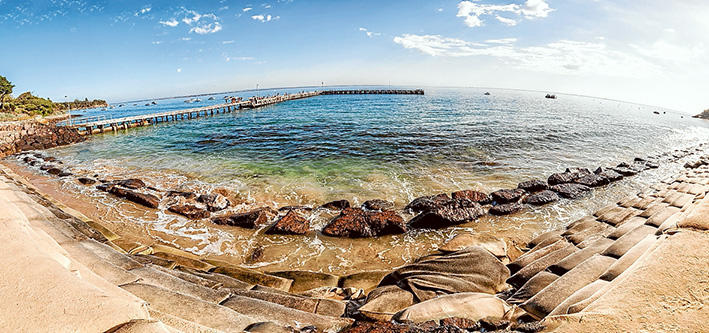
CONTRACTORS are about to be appointed to investigate restoring Portsea’s famed front beach to its former, sand-filled glory.
Following years of arguing over the causes of the sand loss, the Department of Environment, Land, Water and Planning in February called for quotes on the methods and cost of replacing sand and preventing its future erosion.
Background notes provided by the department acknowledge swell waves from Bass Strait as causing Portsea’s sand loss, but does not mention channel deepening in 2008-09, the biggest and most recent change to the Port Phillip seabed.
The Port of Melbourne Corporation denied its two-year $720 million dredging project caused the erosion but two state government-commissioned reports – by Water Technologies and the CSIRO – revealed the removal of sand further out in the bay had changed the shape and power of waves hitting the beach.
Reports of abnormally large waves hitting the front beach were first made in late 2008.
The department has narrowed the remedies for the beach down to six and expects the successful contractor to assess their effectiveness “over a 50 year planning horizon, having a design life of not less than 20 years and not greater than 50 years”.
The six coastal and maritime options to be assessed are:
1. Shaping the seabed with dredging.
2. Building a breakwater seaward of Portsea pier.
3. Installing groynes or artificial headland on the beach east of the pier.
4. Replacing the existing sandbag seawall with a rock seawall.
5. Restoring or renourishing alone or in combination with 1, 2, 3 and 4 above, for example, beach renourishment and a seawall
6. Removing the sandbag seawall to examine beach dynamics, recovery and/or erosion.
The department also specifies which models or computer simulations must be used by contractor when assessing the six remedial options.
The contractor must also predict “potential environmental impacts” of the options on Portsea front beach, in Weeroona Bay and “to the surrounding near shore and down-drift coastline”.
The “transparent and justifiable” costs of the project can have a 30 per cent plus or minus margin for error.
Most of the beach was washed away in 2010 and the government then spent about $3 million to replace lost sand and protect the beach with sandbags and rocks.
The authorities had repeatedly said the beach was destroyed by natural causes such as storms, higher sea levels and natural erosion (“Rocks for Portsea beach”, The News, 8/8/13).
Water Technologies’ report stated channel deepening had created channels that allowed larger and more powerful waves to sweep into the beach.
The CSIRO report stated a change in the local wave conditions was the likely cause of the erosion at Portsea but this could not be measured accurately due to a lack of “long wave records at Portsea beach that pre-date the erosion event and CDP [channel deepening project]”.
It is understood the department’s 17-page tender document was sent to four potential contractors as well the Nepean Ratepayers’ Association.
First published in the Southern Peninsula News – 8 March 2016